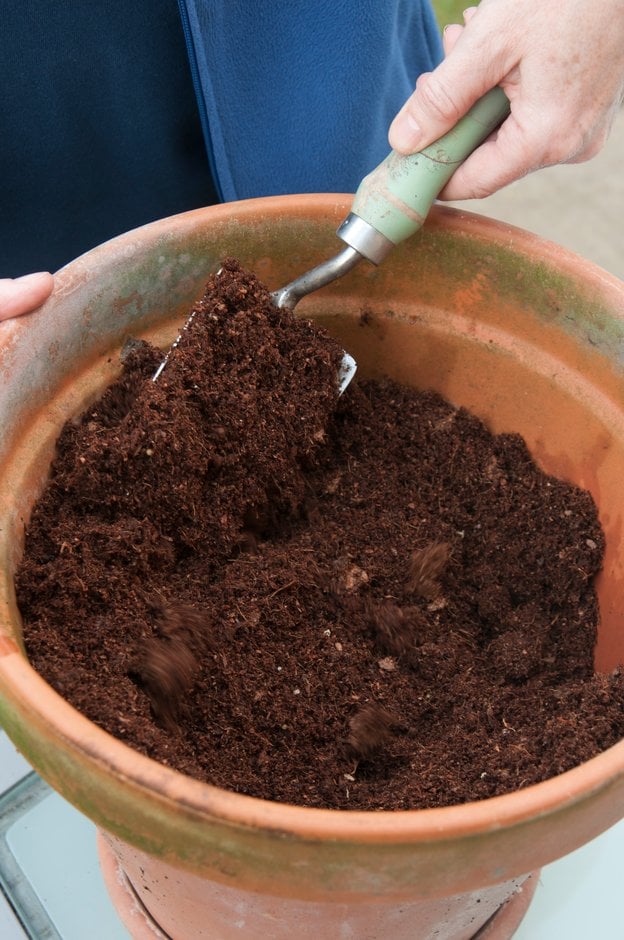Using peat-free compost in your garden is a great way to garden more sustainably. Find out more about peat-free composts and what’s in them

A wide range of peat-free growing media are now available, containing materials including bark, wood fibre, coir (pictured), anaerobic digestate, bracken, waste sheep’s wool, sustainably farmed sphagnum moss and green waste compost.
All growing media mixes, including peat, have slightly different properties. We recommend gardeners read and follow the instructions on the packaging regarding which plants they are best suited to, paying close attention to the watering and feeding requirements.
In the past, peat has been used for soil improvement and mulching, but other materials are better suited to these tasks. Peat is never used as a soil improver or mulch in RHS Gardens.
Soil can be improved by incorporating well-rotted animal manures or composted plant remains; both materials can also be used for mulching. Wood chips, wood shavings and bark are also commonly used as mulches, but home-composted green and food waste do a very good job and leave these resources available to growing media manufacturers to use instead.
There is a lot of competition, particularly for wood products, from the energy and other industries, so the more gardeners can free up these materials for use in more appropriate places, the better.
RHS comparative experiments
We have undertaken a number of trials at our Gardens on peat and peat-free alternatives for the cultivation of ornamentals and vegetables.
The demonstrations have provided first-hand information on the benefits and challenges of different products, showing that plants grown in peat-free alternatives are of comparable quality to those grown in peat.
An RHS experiment on peat-free growing media for a specialist plant group, carnivorous plants – initially Sarracenia (pitcher plants) – tested peat-free mixes, including some using sustainably farmed sphagnum moss. The results were positive, and a panel of carnivorous plant experts judged the peat-free plants to be of higher quality than those grown in peat after a year. As with all growing media, care is required around selection, watering and feeding.
These experiments will continue to investigate the long-term health and quality of the peat-free pitcher plants, and investigate a wider range of peat-free mixes on a variety of carnivorous plant groups.
Sustainability
Sustainable sourcing is an important consideration in the environmental credentials of any peat-free growing media. The RHS has worked with the Horticultural Trades Association, government and industry in developing the Responsible Sourcing Scheme (RSS), which aims to address this issue through an appropriate labelling system.
The RSS label is displayed as a traffic light system on bags of growing media, based on seven different environmental criteria. Looking for this label will allow consumers to make an informed choice.
Main ingredients of peat-free compost
Peat-free potting composts contain blends of various organic (plant-derived) materials – such as composted bark, coir, woodfibre and green compost – sometimes mixed with inorganic materials such as grit, sharp sand, rock wool and perlite. All these materials have their own physical, chemical and biological properties that are also different to those of peat, so it is worth trying a few different compost mixes to find one that suits your garden and the plants you grow.
Some of the most commonly used organic ingredients are:
- Wood fibres – treated wood chips, with different treatments resulting in different materials for different needs. Steam-treatment will give a very loose material, while crushed or milled wood fibres can help improve drainage. Depending on their treatment, wood-based mixes can be tailored to the requirements of most plants.
- Coir or coconut fibre – the husks of the coconut, which would otherwise be a waste product, mainly imported from Sri Lanka and India. Coir has excellent water-holding abilities and its mix of fine and coarse fibres makes it light and porous, which provides good growing conditions. However, it doesn’t hold nutrients as well as some other materials.
- Wood bark – most often the bark of pine trees, again this component can be treated in different ways to give the bark various properties for different uses. Bark is very stable and porous, so can help add air to a compost.
- Green compost – many local authorities and private companies collect and anaerobically compost green waste. The resulting compost tends to have a high nutrient content but can be very variable throughout the year without careful management. There is an industry standard for green compost to ensure a high quality and consistent product. The RHS is part of Enrich the Earth, a movement of organisations seeking to unlock the benefits of green waste. They are undertaking trials of localised composted green waste and food waste as a replacement for peat.
Other ingredients
Research is ongoing into a number of materials that, if locally available, may be useful ingredients in blended products, such as arable straw waste, sustainably farmed sphagnun moss, wool waste and paper and cardboard production waste.
Home-made potting compost
You can mix your own peat-free potting compost using home-made garden compost, leafmould and inorganic materials (loam and sand). This has the great benefits of being very low cost and having a much smaller carbon footprint than buying bagged compost, but the results can be variable. It can be difficult to standardise the pH, moisture retention and available nutrients in your compost throughout the year, and to ensure that the final mix is weed-free.
Home-made potting composts are best avoided for seed sowing, because of the potential for them to contain fungi that can harm seedlings or cause damping-off disease.
See also

